Critical Evaluation of Failure to Rescue in Acute Healthcare Essay
VerifiedAdded on 2023/01/16
|9
|2427
|41
Essay
AI Summary
This essay critically evaluates the concept of "failure to rescue" in the acute healthcare environment, focusing on the deteriorating patient. It defines failure to rescue, discusses its incidence and consequences, particularly in the Australian context, and explores various prevention strategies. The essay emphasizes the role of nursing strategies, including electronic patient data and proactive medical surveillance tools, in mitigating the risks associated with failure to rescue. It also highlights the importance of interprofessional practice, such as high-reliable teams of interprofessional collaboration, to prevent and address the impacts of failure to rescue, while also identifying barriers to the implementation of these strategies. The analysis underscores the need for effective teamwork, communication, and patient-centered approaches to enhance patient safety and improve outcomes.
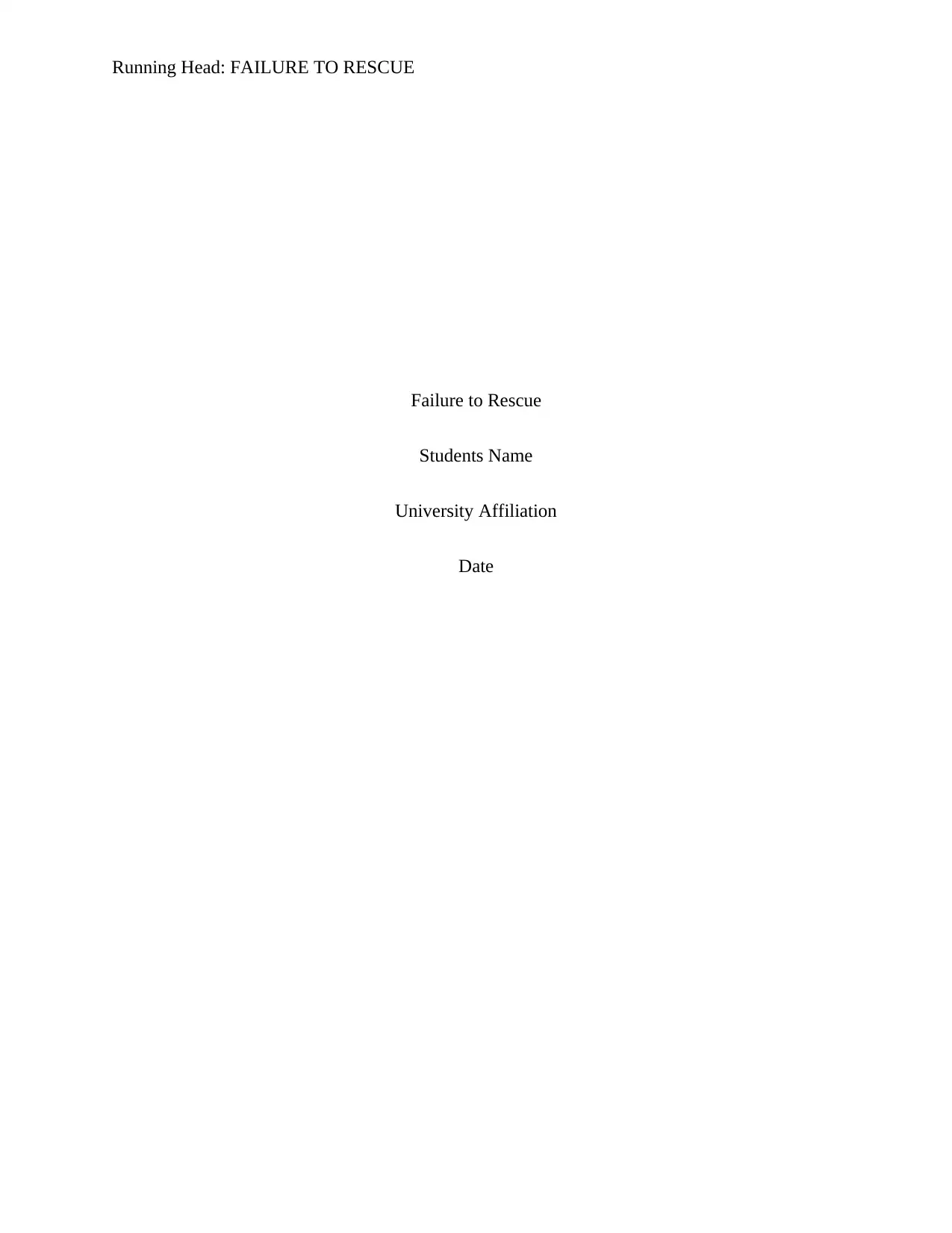
Running Head: FAILURE TO RESCUE
Failure to Rescue
Students Name
University Affiliation
Date
Failure to Rescue
Students Name
University Affiliation
Date
Paraphrase This Document
Need a fresh take? Get an instant paraphrase of this document with our AI Paraphraser
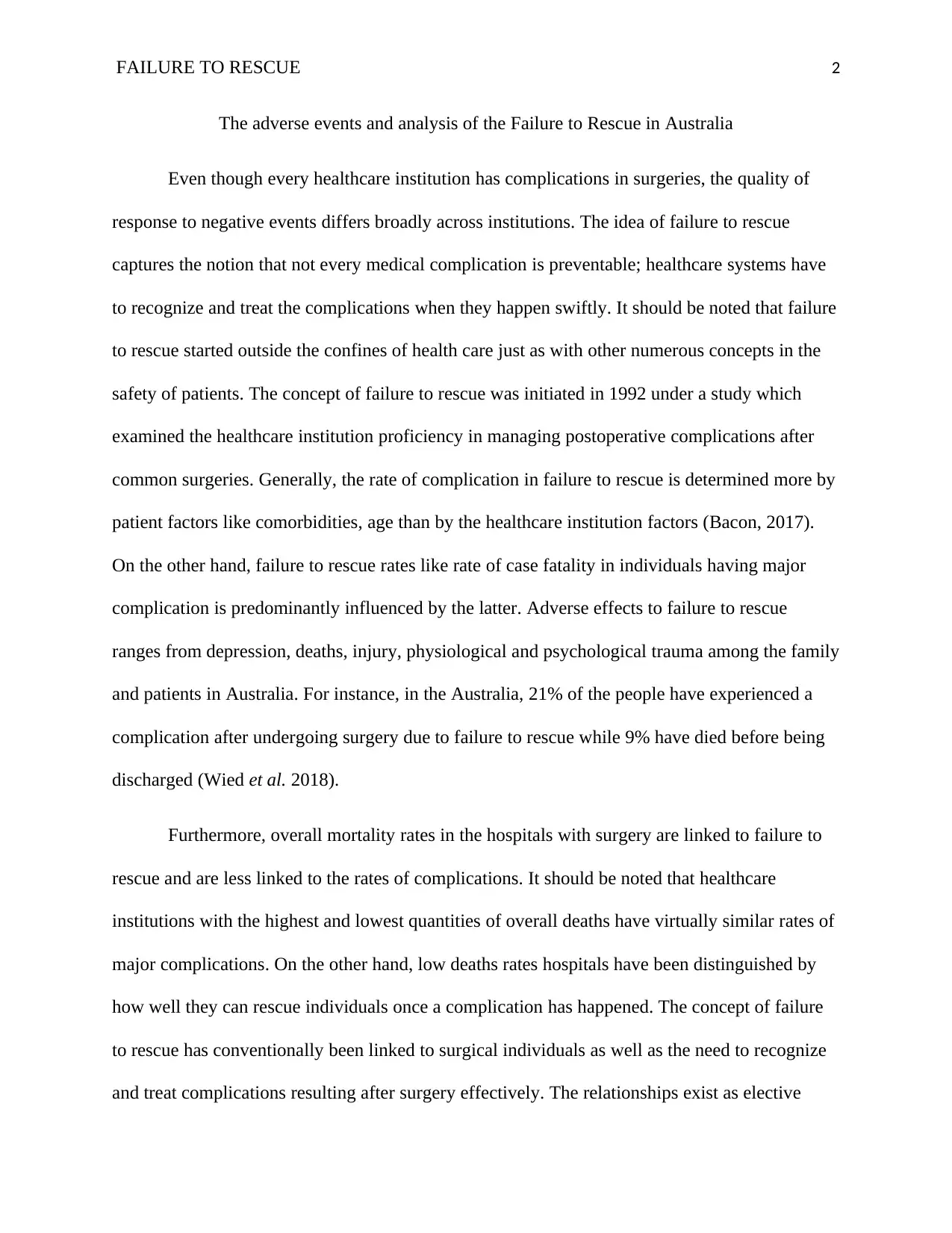
FAILURE TO RESCUE 2
The adverse events and analysis of the Failure to Rescue in Australia
Even though every healthcare institution has complications in surgeries, the quality of
response to negative events differs broadly across institutions. The idea of failure to rescue
captures the notion that not every medical complication is preventable; healthcare systems have
to recognize and treat the complications when they happen swiftly. It should be noted that failure
to rescue started outside the confines of health care just as with other numerous concepts in the
safety of patients. The concept of failure to rescue was initiated in 1992 under a study which
examined the healthcare institution proficiency in managing postoperative complications after
common surgeries. Generally, the rate of complication in failure to rescue is determined more by
patient factors like comorbidities, age than by the healthcare institution factors (Bacon, 2017).
On the other hand, failure to rescue rates like rate of case fatality in individuals having major
complication is predominantly influenced by the latter. Adverse effects to failure to rescue
ranges from depression, deaths, injury, physiological and psychological trauma among the family
and patients in Australia. For instance, in the Australia, 21% of the people have experienced a
complication after undergoing surgery due to failure to rescue while 9% have died before being
discharged (Wied et al. 2018).
Furthermore, overall mortality rates in the hospitals with surgery are linked to failure to
rescue and are less linked to the rates of complications. It should be noted that healthcare
institutions with the highest and lowest quantities of overall deaths have virtually similar rates of
major complications. On the other hand, low deaths rates hospitals have been distinguished by
how well they can rescue individuals once a complication has happened. The concept of failure
to rescue has conventionally been linked to surgical individuals as well as the need to recognize
and treat complications resulting after surgery effectively. The relationships exist as elective
The adverse events and analysis of the Failure to Rescue in Australia
Even though every healthcare institution has complications in surgeries, the quality of
response to negative events differs broadly across institutions. The idea of failure to rescue
captures the notion that not every medical complication is preventable; healthcare systems have
to recognize and treat the complications when they happen swiftly. It should be noted that failure
to rescue started outside the confines of health care just as with other numerous concepts in the
safety of patients. The concept of failure to rescue was initiated in 1992 under a study which
examined the healthcare institution proficiency in managing postoperative complications after
common surgeries. Generally, the rate of complication in failure to rescue is determined more by
patient factors like comorbidities, age than by the healthcare institution factors (Bacon, 2017).
On the other hand, failure to rescue rates like rate of case fatality in individuals having major
complication is predominantly influenced by the latter. Adverse effects to failure to rescue
ranges from depression, deaths, injury, physiological and psychological trauma among the family
and patients in Australia. For instance, in the Australia, 21% of the people have experienced a
complication after undergoing surgery due to failure to rescue while 9% have died before being
discharged (Wied et al. 2018).
Furthermore, overall mortality rates in the hospitals with surgery are linked to failure to
rescue and are less linked to the rates of complications. It should be noted that healthcare
institutions with the highest and lowest quantities of overall deaths have virtually similar rates of
major complications. On the other hand, low deaths rates hospitals have been distinguished by
how well they can rescue individuals once a complication has happened. The concept of failure
to rescue has conventionally been linked to surgical individuals as well as the need to recognize
and treat complications resulting after surgery effectively. The relationships exist as elective
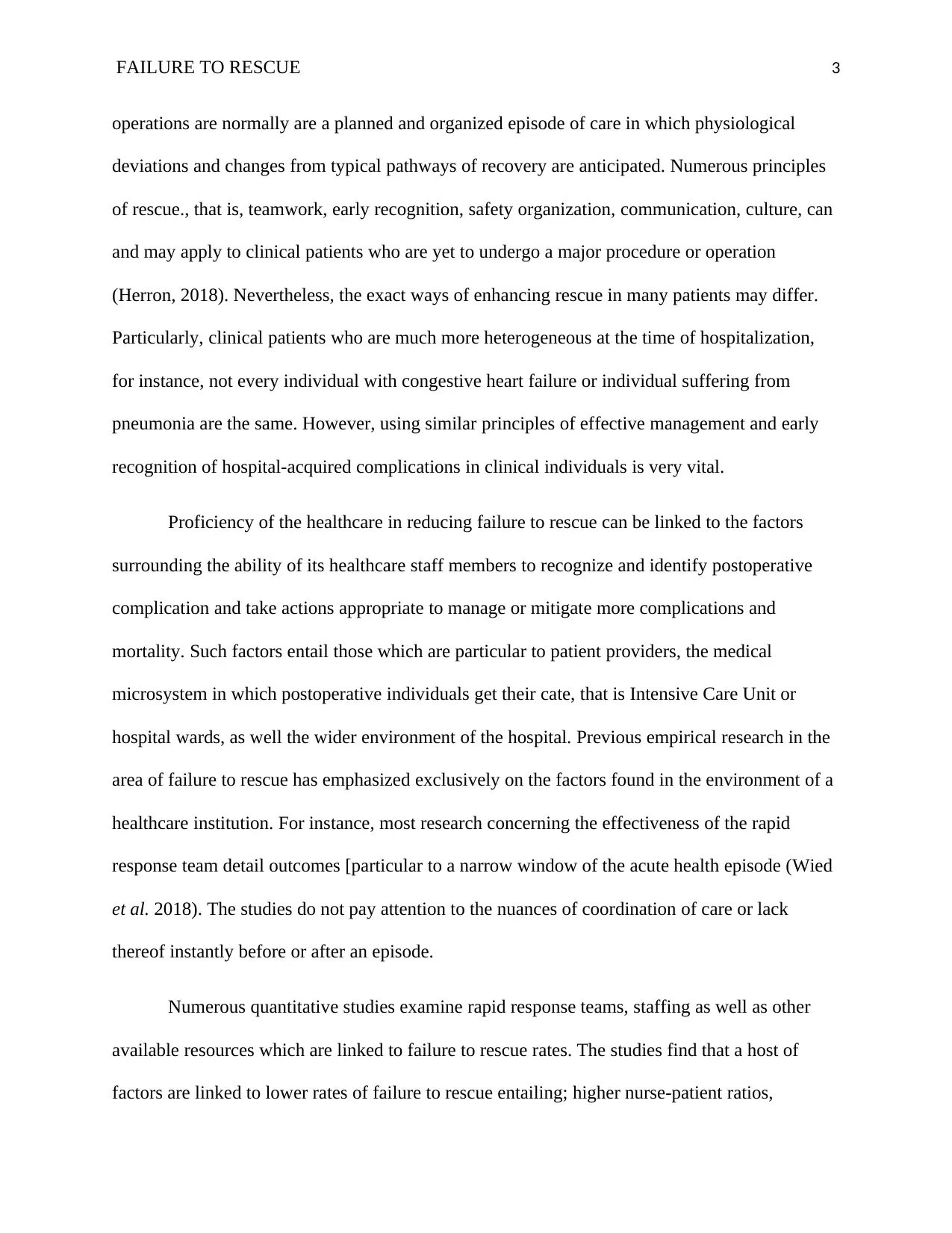
FAILURE TO RESCUE 3
operations are normally are a planned and organized episode of care in which physiological
deviations and changes from typical pathways of recovery are anticipated. Numerous principles
of rescue., that is, teamwork, early recognition, safety organization, communication, culture, can
and may apply to clinical patients who are yet to undergo a major procedure or operation
(Herron, 2018). Nevertheless, the exact ways of enhancing rescue in many patients may differ.
Particularly, clinical patients who are much more heterogeneous at the time of hospitalization,
for instance, not every individual with congestive heart failure or individual suffering from
pneumonia are the same. However, using similar principles of effective management and early
recognition of hospital-acquired complications in clinical individuals is very vital.
Proficiency of the healthcare in reducing failure to rescue can be linked to the factors
surrounding the ability of its healthcare staff members to recognize and identify postoperative
complication and take actions appropriate to manage or mitigate more complications and
mortality. Such factors entail those which are particular to patient providers, the medical
microsystem in which postoperative individuals get their cate, that is Intensive Care Unit or
hospital wards, as well the wider environment of the hospital. Previous empirical research in the
area of failure to rescue has emphasized exclusively on the factors found in the environment of a
healthcare institution. For instance, most research concerning the effectiveness of the rapid
response team detail outcomes [particular to a narrow window of the acute health episode (Wied
et al. 2018). The studies do not pay attention to the nuances of coordination of care or lack
thereof instantly before or after an episode.
Numerous quantitative studies examine rapid response teams, staffing as well as other
available resources which are linked to failure to rescue rates. The studies find that a host of
factors are linked to lower rates of failure to rescue entailing; higher nurse-patient ratios,
operations are normally are a planned and organized episode of care in which physiological
deviations and changes from typical pathways of recovery are anticipated. Numerous principles
of rescue., that is, teamwork, early recognition, safety organization, communication, culture, can
and may apply to clinical patients who are yet to undergo a major procedure or operation
(Herron, 2018). Nevertheless, the exact ways of enhancing rescue in many patients may differ.
Particularly, clinical patients who are much more heterogeneous at the time of hospitalization,
for instance, not every individual with congestive heart failure or individual suffering from
pneumonia are the same. However, using similar principles of effective management and early
recognition of hospital-acquired complications in clinical individuals is very vital.
Proficiency of the healthcare in reducing failure to rescue can be linked to the factors
surrounding the ability of its healthcare staff members to recognize and identify postoperative
complication and take actions appropriate to manage or mitigate more complications and
mortality. Such factors entail those which are particular to patient providers, the medical
microsystem in which postoperative individuals get their cate, that is Intensive Care Unit or
hospital wards, as well the wider environment of the hospital. Previous empirical research in the
area of failure to rescue has emphasized exclusively on the factors found in the environment of a
healthcare institution. For instance, most research concerning the effectiveness of the rapid
response team detail outcomes [particular to a narrow window of the acute health episode (Wied
et al. 2018). The studies do not pay attention to the nuances of coordination of care or lack
thereof instantly before or after an episode.
Numerous quantitative studies examine rapid response teams, staffing as well as other
available resources which are linked to failure to rescue rates. The studies find that a host of
factors are linked to lower rates of failure to rescue entailing; higher nurse-patient ratios,
⊘ This is a preview!⊘
Do you want full access?
Subscribe today to unlock all pages.

Trusted by 1+ million students worldwide
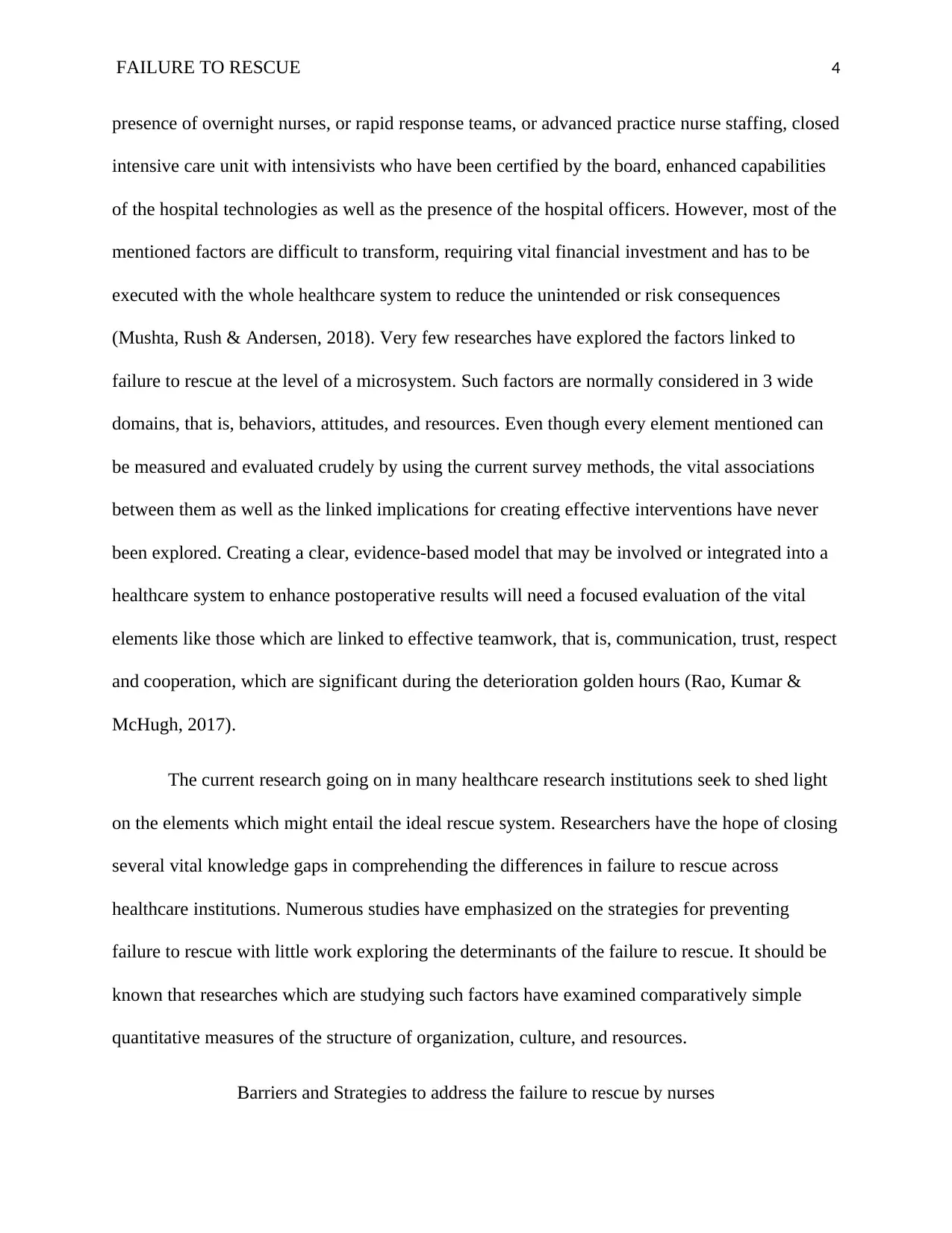
FAILURE TO RESCUE 4
presence of overnight nurses, or rapid response teams, or advanced practice nurse staffing, closed
intensive care unit with intensivists who have been certified by the board, enhanced capabilities
of the hospital technologies as well as the presence of the hospital officers. However, most of the
mentioned factors are difficult to transform, requiring vital financial investment and has to be
executed with the whole healthcare system to reduce the unintended or risk consequences
(Mushta, Rush & Andersen, 2018). Very few researches have explored the factors linked to
failure to rescue at the level of a microsystem. Such factors are normally considered in 3 wide
domains, that is, behaviors, attitudes, and resources. Even though every element mentioned can
be measured and evaluated crudely by using the current survey methods, the vital associations
between them as well as the linked implications for creating effective interventions have never
been explored. Creating a clear, evidence-based model that may be involved or integrated into a
healthcare system to enhance postoperative results will need a focused evaluation of the vital
elements like those which are linked to effective teamwork, that is, communication, trust, respect
and cooperation, which are significant during the deterioration golden hours (Rao, Kumar &
McHugh, 2017).
The current research going on in many healthcare research institutions seek to shed light
on the elements which might entail the ideal rescue system. Researchers have the hope of closing
several vital knowledge gaps in comprehending the differences in failure to rescue across
healthcare institutions. Numerous studies have emphasized on the strategies for preventing
failure to rescue with little work exploring the determinants of the failure to rescue. It should be
known that researches which are studying such factors have examined comparatively simple
quantitative measures of the structure of organization, culture, and resources.
Barriers and Strategies to address the failure to rescue by nurses
presence of overnight nurses, or rapid response teams, or advanced practice nurse staffing, closed
intensive care unit with intensivists who have been certified by the board, enhanced capabilities
of the hospital technologies as well as the presence of the hospital officers. However, most of the
mentioned factors are difficult to transform, requiring vital financial investment and has to be
executed with the whole healthcare system to reduce the unintended or risk consequences
(Mushta, Rush & Andersen, 2018). Very few researches have explored the factors linked to
failure to rescue at the level of a microsystem. Such factors are normally considered in 3 wide
domains, that is, behaviors, attitudes, and resources. Even though every element mentioned can
be measured and evaluated crudely by using the current survey methods, the vital associations
between them as well as the linked implications for creating effective interventions have never
been explored. Creating a clear, evidence-based model that may be involved or integrated into a
healthcare system to enhance postoperative results will need a focused evaluation of the vital
elements like those which are linked to effective teamwork, that is, communication, trust, respect
and cooperation, which are significant during the deterioration golden hours (Rao, Kumar &
McHugh, 2017).
The current research going on in many healthcare research institutions seek to shed light
on the elements which might entail the ideal rescue system. Researchers have the hope of closing
several vital knowledge gaps in comprehending the differences in failure to rescue across
healthcare institutions. Numerous studies have emphasized on the strategies for preventing
failure to rescue with little work exploring the determinants of the failure to rescue. It should be
known that researches which are studying such factors have examined comparatively simple
quantitative measures of the structure of organization, culture, and resources.
Barriers and Strategies to address the failure to rescue by nurses
Paraphrase This Document
Need a fresh take? Get an instant paraphrase of this document with our AI Paraphraser
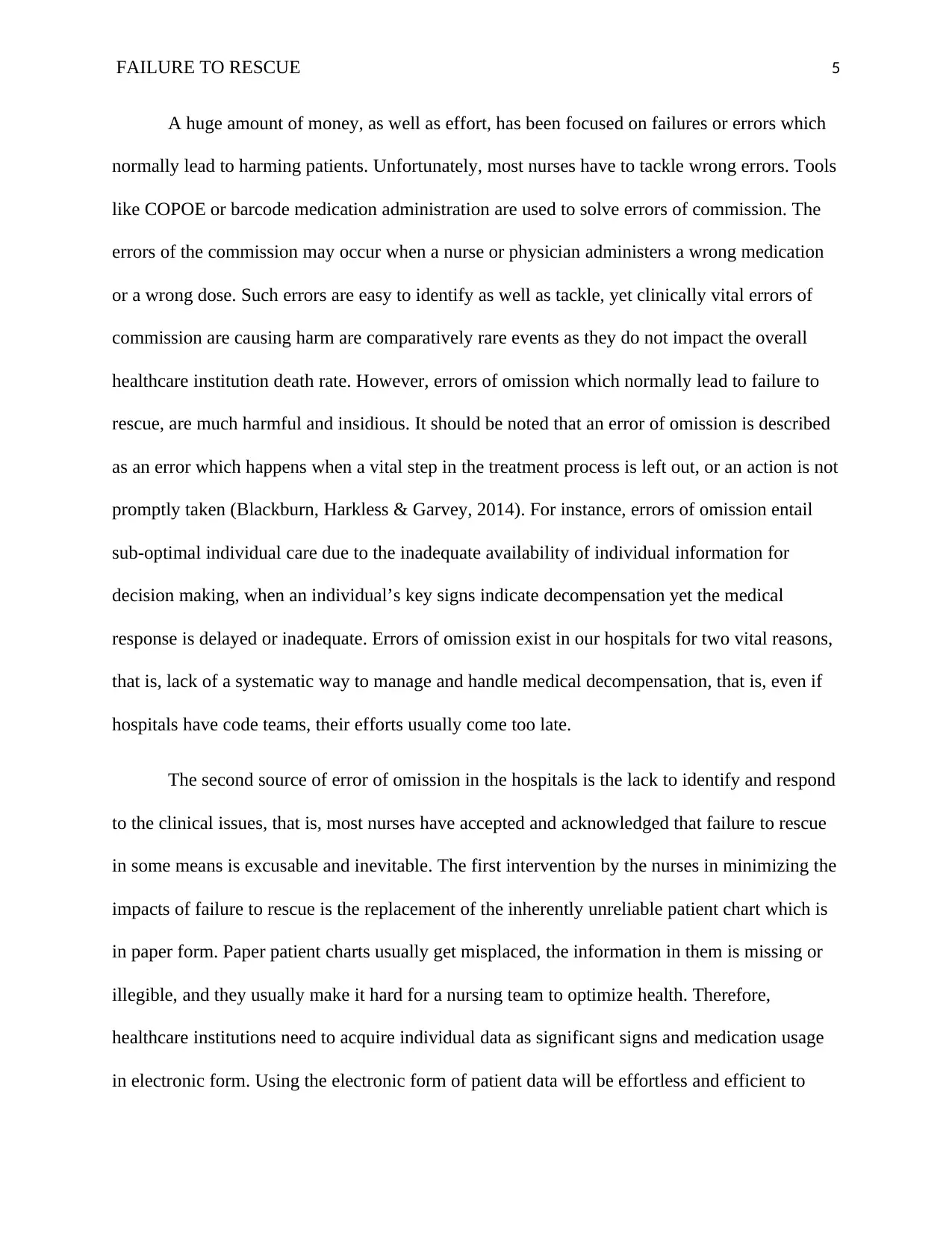
FAILURE TO RESCUE 5
A huge amount of money, as well as effort, has been focused on failures or errors which
normally lead to harming patients. Unfortunately, most nurses have to tackle wrong errors. Tools
like COPOE or barcode medication administration are used to solve errors of commission. The
errors of the commission may occur when a nurse or physician administers a wrong medication
or a wrong dose. Such errors are easy to identify as well as tackle, yet clinically vital errors of
commission are causing harm are comparatively rare events as they do not impact the overall
healthcare institution death rate. However, errors of omission which normally lead to failure to
rescue, are much harmful and insidious. It should be noted that an error of omission is described
as an error which happens when a vital step in the treatment process is left out, or an action is not
promptly taken (Blackburn, Harkless & Garvey, 2014). For instance, errors of omission entail
sub-optimal individual care due to the inadequate availability of individual information for
decision making, when an individual’s key signs indicate decompensation yet the medical
response is delayed or inadequate. Errors of omission exist in our hospitals for two vital reasons,
that is, lack of a systematic way to manage and handle medical decompensation, that is, even if
hospitals have code teams, their efforts usually come too late.
The second source of error of omission in the hospitals is the lack to identify and respond
to the clinical issues, that is, most nurses have accepted and acknowledged that failure to rescue
in some means is excusable and inevitable. The first intervention by the nurses in minimizing the
impacts of failure to rescue is the replacement of the inherently unreliable patient chart which is
in paper form. Paper patient charts usually get misplaced, the information in them is missing or
illegible, and they usually make it hard for a nursing team to optimize health. Therefore,
healthcare institutions need to acquire individual data as significant signs and medication usage
in electronic form. Using the electronic form of patient data will be effortless and efficient to
A huge amount of money, as well as effort, has been focused on failures or errors which
normally lead to harming patients. Unfortunately, most nurses have to tackle wrong errors. Tools
like COPOE or barcode medication administration are used to solve errors of commission. The
errors of the commission may occur when a nurse or physician administers a wrong medication
or a wrong dose. Such errors are easy to identify as well as tackle, yet clinically vital errors of
commission are causing harm are comparatively rare events as they do not impact the overall
healthcare institution death rate. However, errors of omission which normally lead to failure to
rescue, are much harmful and insidious. It should be noted that an error of omission is described
as an error which happens when a vital step in the treatment process is left out, or an action is not
promptly taken (Blackburn, Harkless & Garvey, 2014). For instance, errors of omission entail
sub-optimal individual care due to the inadequate availability of individual information for
decision making, when an individual’s key signs indicate decompensation yet the medical
response is delayed or inadequate. Errors of omission exist in our hospitals for two vital reasons,
that is, lack of a systematic way to manage and handle medical decompensation, that is, even if
hospitals have code teams, their efforts usually come too late.
The second source of error of omission in the hospitals is the lack to identify and respond
to the clinical issues, that is, most nurses have accepted and acknowledged that failure to rescue
in some means is excusable and inevitable. The first intervention by the nurses in minimizing the
impacts of failure to rescue is the replacement of the inherently unreliable patient chart which is
in paper form. Paper patient charts usually get misplaced, the information in them is missing or
illegible, and they usually make it hard for a nursing team to optimize health. Therefore,
healthcare institutions need to acquire individual data as significant signs and medication usage
in electronic form. Using the electronic form of patient data will be effortless and efficient to
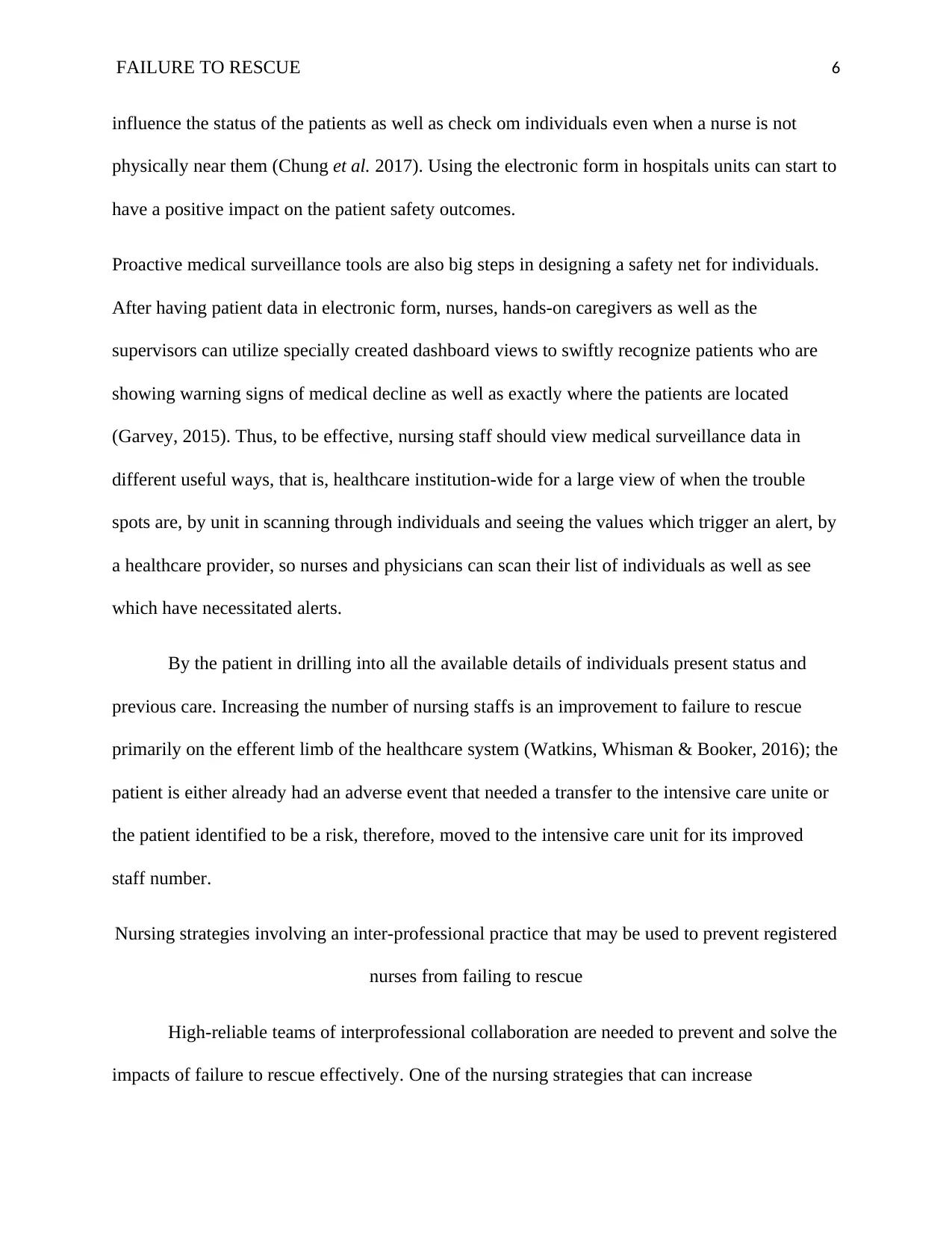
FAILURE TO RESCUE 6
influence the status of the patients as well as check om individuals even when a nurse is not
physically near them (Chung et al. 2017). Using the electronic form in hospitals units can start to
have a positive impact on the patient safety outcomes.
Proactive medical surveillance tools are also big steps in designing a safety net for individuals.
After having patient data in electronic form, nurses, hands-on caregivers as well as the
supervisors can utilize specially created dashboard views to swiftly recognize patients who are
showing warning signs of medical decline as well as exactly where the patients are located
(Garvey, 2015). Thus, to be effective, nursing staff should view medical surveillance data in
different useful ways, that is, healthcare institution-wide for a large view of when the trouble
spots are, by unit in scanning through individuals and seeing the values which trigger an alert, by
a healthcare provider, so nurses and physicians can scan their list of individuals as well as see
which have necessitated alerts.
By the patient in drilling into all the available details of individuals present status and
previous care. Increasing the number of nursing staffs is an improvement to failure to rescue
primarily on the efferent limb of the healthcare system (Watkins, Whisman & Booker, 2016); the
patient is either already had an adverse event that needed a transfer to the intensive care unite or
the patient identified to be a risk, therefore, moved to the intensive care unit for its improved
staff number.
Nursing strategies involving an inter-professional practice that may be used to prevent registered
nurses from failing to rescue
High-reliable teams of interprofessional collaboration are needed to prevent and solve the
impacts of failure to rescue effectively. One of the nursing strategies that can increase
influence the status of the patients as well as check om individuals even when a nurse is not
physically near them (Chung et al. 2017). Using the electronic form in hospitals units can start to
have a positive impact on the patient safety outcomes.
Proactive medical surveillance tools are also big steps in designing a safety net for individuals.
After having patient data in electronic form, nurses, hands-on caregivers as well as the
supervisors can utilize specially created dashboard views to swiftly recognize patients who are
showing warning signs of medical decline as well as exactly where the patients are located
(Garvey, 2015). Thus, to be effective, nursing staff should view medical surveillance data in
different useful ways, that is, healthcare institution-wide for a large view of when the trouble
spots are, by unit in scanning through individuals and seeing the values which trigger an alert, by
a healthcare provider, so nurses and physicians can scan their list of individuals as well as see
which have necessitated alerts.
By the patient in drilling into all the available details of individuals present status and
previous care. Increasing the number of nursing staffs is an improvement to failure to rescue
primarily on the efferent limb of the healthcare system (Watkins, Whisman & Booker, 2016); the
patient is either already had an adverse event that needed a transfer to the intensive care unite or
the patient identified to be a risk, therefore, moved to the intensive care unit for its improved
staff number.
Nursing strategies involving an inter-professional practice that may be used to prevent registered
nurses from failing to rescue
High-reliable teams of interprofessional collaboration are needed to prevent and solve the
impacts of failure to rescue effectively. One of the nursing strategies that can increase
⊘ This is a preview!⊘
Do you want full access?
Subscribe today to unlock all pages.

Trusted by 1+ million students worldwide
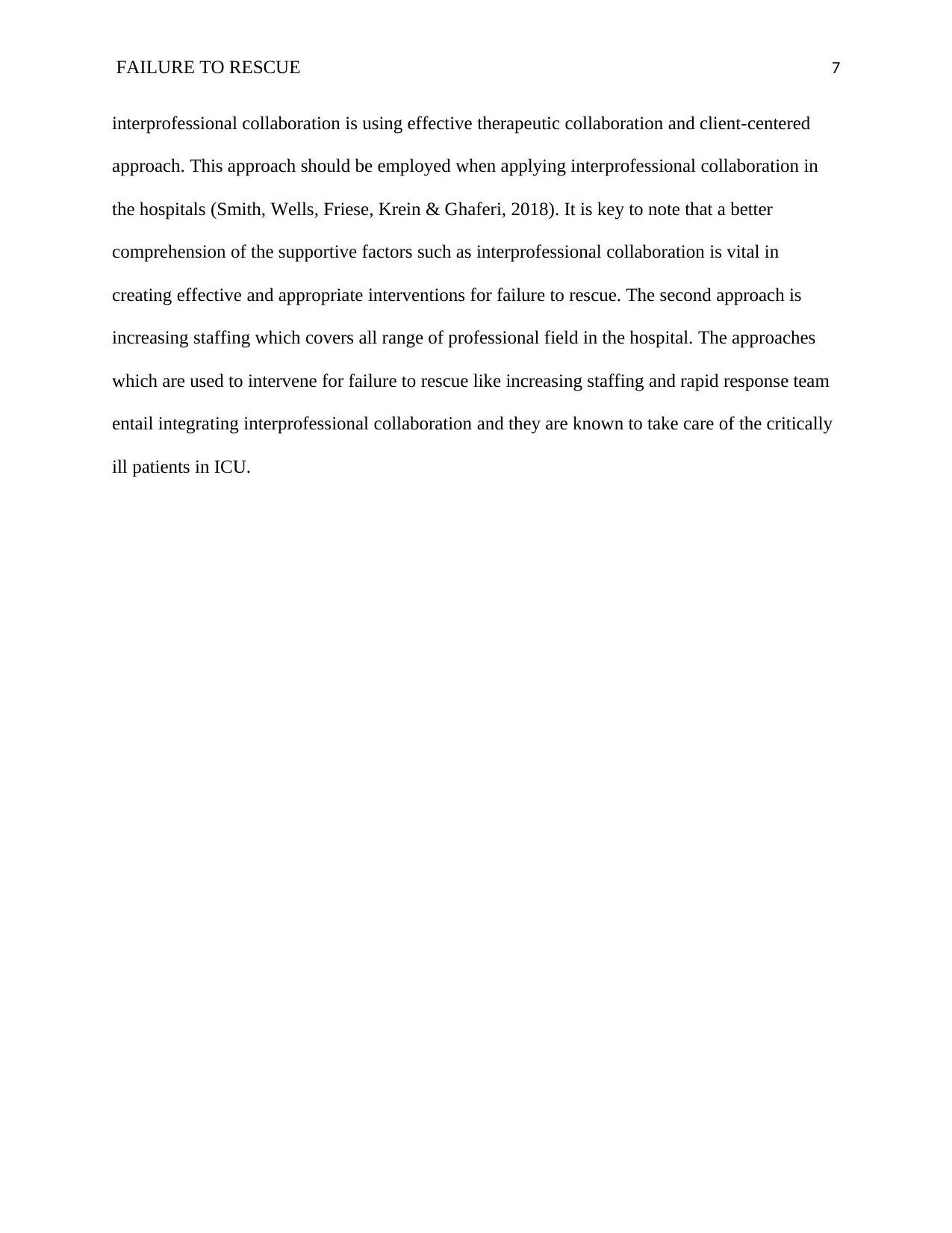
FAILURE TO RESCUE 7
interprofessional collaboration is using effective therapeutic collaboration and client-centered
approach. This approach should be employed when applying interprofessional collaboration in
the hospitals (Smith, Wells, Friese, Krein & Ghaferi, 2018). It is key to note that a better
comprehension of the supportive factors such as interprofessional collaboration is vital in
creating effective and appropriate interventions for failure to rescue. The second approach is
increasing staffing which covers all range of professional field in the hospital. The approaches
which are used to intervene for failure to rescue like increasing staffing and rapid response team
entail integrating interprofessional collaboration and they are known to take care of the critically
ill patients in ICU.
interprofessional collaboration is using effective therapeutic collaboration and client-centered
approach. This approach should be employed when applying interprofessional collaboration in
the hospitals (Smith, Wells, Friese, Krein & Ghaferi, 2018). It is key to note that a better
comprehension of the supportive factors such as interprofessional collaboration is vital in
creating effective and appropriate interventions for failure to rescue. The second approach is
increasing staffing which covers all range of professional field in the hospital. The approaches
which are used to intervene for failure to rescue like increasing staffing and rapid response team
entail integrating interprofessional collaboration and they are known to take care of the critically
ill patients in ICU.
Paraphrase This Document
Need a fresh take? Get an instant paraphrase of this document with our AI Paraphraser
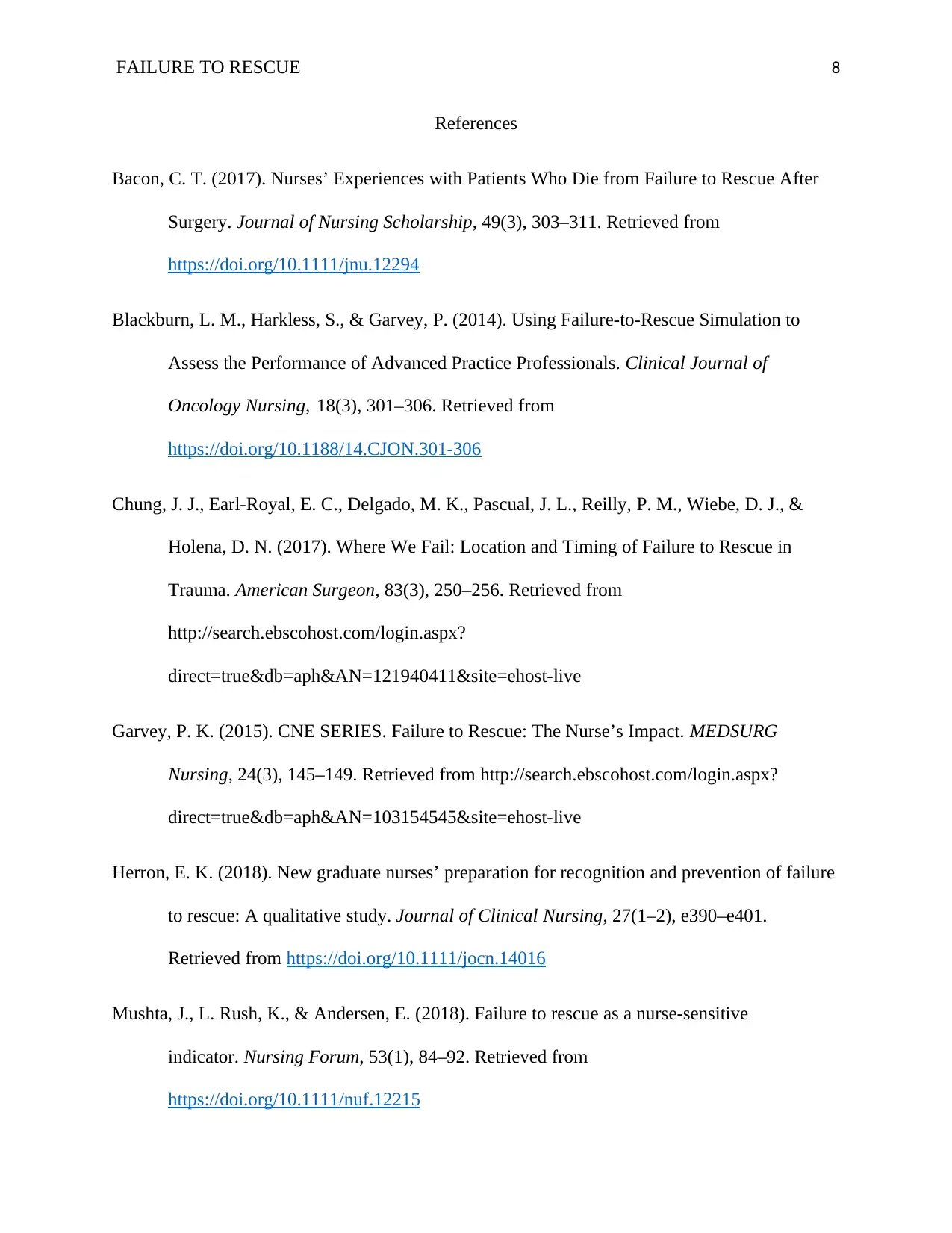
FAILURE TO RESCUE 8
References
Bacon, C. T. (2017). Nurses’ Experiences with Patients Who Die from Failure to Rescue After
Surgery. Journal of Nursing Scholarship, 49(3), 303–311. Retrieved from
https://doi.org/10.1111/jnu.12294
Blackburn, L. M., Harkless, S., & Garvey, P. (2014). Using Failure-to-Rescue Simulation to
Assess the Performance of Advanced Practice Professionals. Clinical Journal of
Oncology Nursing, 18(3), 301–306. Retrieved from
https://doi.org/10.1188/14.CJON.301-306
Chung, J. J., Earl-Royal, E. C., Delgado, M. K., Pascual, J. L., Reilly, P. M., Wiebe, D. J., &
Holena, D. N. (2017). Where We Fail: Location and Timing of Failure to Rescue in
Trauma. American Surgeon, 83(3), 250–256. Retrieved from
http://search.ebscohost.com/login.aspx?
direct=true&db=aph&AN=121940411&site=ehost-live
Garvey, P. K. (2015). CNE SERIES. Failure to Rescue: The Nurse’s Impact. MEDSURG
Nursing, 24(3), 145–149. Retrieved from http://search.ebscohost.com/login.aspx?
direct=true&db=aph&AN=103154545&site=ehost-live
Herron, E. K. (2018). New graduate nurses’ preparation for recognition and prevention of failure
to rescue: A qualitative study. Journal of Clinical Nursing, 27(1–2), e390–e401.
Retrieved from https://doi.org/10.1111/jocn.14016
Mushta, J., L. Rush, K., & Andersen, E. (2018). Failure to rescue as a nurse‐sensitive
indicator. Nursing Forum, 53(1), 84–92. Retrieved from
https://doi.org/10.1111/nuf.12215
References
Bacon, C. T. (2017). Nurses’ Experiences with Patients Who Die from Failure to Rescue After
Surgery. Journal of Nursing Scholarship, 49(3), 303–311. Retrieved from
https://doi.org/10.1111/jnu.12294
Blackburn, L. M., Harkless, S., & Garvey, P. (2014). Using Failure-to-Rescue Simulation to
Assess the Performance of Advanced Practice Professionals. Clinical Journal of
Oncology Nursing, 18(3), 301–306. Retrieved from
https://doi.org/10.1188/14.CJON.301-306
Chung, J. J., Earl-Royal, E. C., Delgado, M. K., Pascual, J. L., Reilly, P. M., Wiebe, D. J., &
Holena, D. N. (2017). Where We Fail: Location and Timing of Failure to Rescue in
Trauma. American Surgeon, 83(3), 250–256. Retrieved from
http://search.ebscohost.com/login.aspx?
direct=true&db=aph&AN=121940411&site=ehost-live
Garvey, P. K. (2015). CNE SERIES. Failure to Rescue: The Nurse’s Impact. MEDSURG
Nursing, 24(3), 145–149. Retrieved from http://search.ebscohost.com/login.aspx?
direct=true&db=aph&AN=103154545&site=ehost-live
Herron, E. K. (2018). New graduate nurses’ preparation for recognition and prevention of failure
to rescue: A qualitative study. Journal of Clinical Nursing, 27(1–2), e390–e401.
Retrieved from https://doi.org/10.1111/jocn.14016
Mushta, J., L. Rush, K., & Andersen, E. (2018). Failure to rescue as a nurse‐sensitive
indicator. Nursing Forum, 53(1), 84–92. Retrieved from
https://doi.org/10.1111/nuf.12215
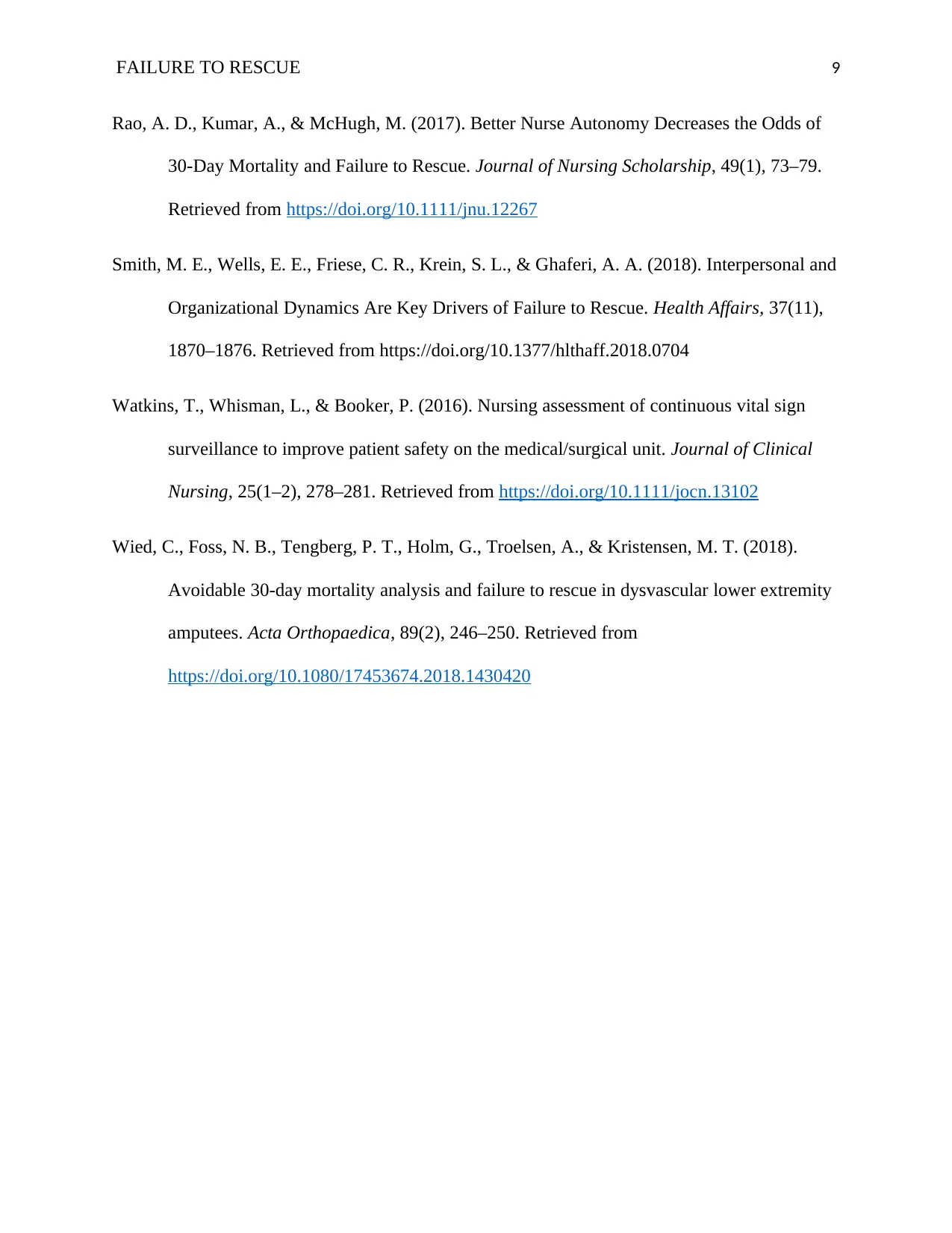
FAILURE TO RESCUE 9
Rao, A. D., Kumar, A., & McHugh, M. (2017). Better Nurse Autonomy Decreases the Odds of
30-Day Mortality and Failure to Rescue. Journal of Nursing Scholarship, 49(1), 73–79.
Retrieved from https://doi.org/10.1111/jnu.12267
Smith, M. E., Wells, E. E., Friese, C. R., Krein, S. L., & Ghaferi, A. A. (2018). Interpersonal and
Organizational Dynamics Are Key Drivers of Failure to Rescue. Health Affairs, 37(11),
1870–1876. Retrieved from https://doi.org/10.1377/hlthaff.2018.0704
Watkins, T., Whisman, L., & Booker, P. (2016). Nursing assessment of continuous vital sign
surveillance to improve patient safety on the medical/surgical unit. Journal of Clinical
Nursing, 25(1–2), 278–281. Retrieved from https://doi.org/10.1111/jocn.13102
Wied, C., Foss, N. B., Tengberg, P. T., Holm, G., Troelsen, A., & Kristensen, M. T. (2018).
Avoidable 30-day mortality analysis and failure to rescue in dysvascular lower extremity
amputees. Acta Orthopaedica, 89(2), 246–250. Retrieved from
https://doi.org/10.1080/17453674.2018.1430420
Rao, A. D., Kumar, A., & McHugh, M. (2017). Better Nurse Autonomy Decreases the Odds of
30-Day Mortality and Failure to Rescue. Journal of Nursing Scholarship, 49(1), 73–79.
Retrieved from https://doi.org/10.1111/jnu.12267
Smith, M. E., Wells, E. E., Friese, C. R., Krein, S. L., & Ghaferi, A. A. (2018). Interpersonal and
Organizational Dynamics Are Key Drivers of Failure to Rescue. Health Affairs, 37(11),
1870–1876. Retrieved from https://doi.org/10.1377/hlthaff.2018.0704
Watkins, T., Whisman, L., & Booker, P. (2016). Nursing assessment of continuous vital sign
surveillance to improve patient safety on the medical/surgical unit. Journal of Clinical
Nursing, 25(1–2), 278–281. Retrieved from https://doi.org/10.1111/jocn.13102
Wied, C., Foss, N. B., Tengberg, P. T., Holm, G., Troelsen, A., & Kristensen, M. T. (2018).
Avoidable 30-day mortality analysis and failure to rescue in dysvascular lower extremity
amputees. Acta Orthopaedica, 89(2), 246–250. Retrieved from
https://doi.org/10.1080/17453674.2018.1430420
⊘ This is a preview!⊘
Do you want full access?
Subscribe today to unlock all pages.

Trusted by 1+ million students worldwide
1 out of 9
Related Documents
Your All-in-One AI-Powered Toolkit for Academic Success.
+13062052269
info@desklib.com
Available 24*7 on WhatsApp / Email
![[object Object]](/_next/static/media/star-bottom.7253800d.svg)
Unlock your academic potential
Copyright © 2020–2025 A2Z Services. All Rights Reserved. Developed and managed by ZUCOL.





